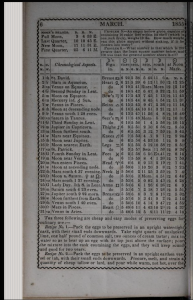
Turner’s North Carolina Almanac. 1855. Henry D. Turner. University of North Carolina at Chapel Hill Libraries. Wilson Library Internet Archive. Archive.org.
Families across the United States faced unique challenges when it came to providing and preserving food leading up to, during, and after the times of enslavement and war. Raleigh, North Carolina, used the Turner’s North Carolina Almanac to provide locals with an updated yearly outlook including moon phases, useful recipes, miscellaneous materials, and more. Specifically, in 1855, before the Civil War, readers were provided with a useful recipe on how to preserve eggs for future culinary use. Eggs were not a cheap item during this time going for up to $0.28 per dozen eggs. [1] This recipe included putting the eggs in an watertight canister with the small end down. The user then needed eight quarts of unslaked lime, a half pound of salt, and two ounces of cream tartar. The next step says to mix these ingredients with the water and pour it over the eggs until all but the top of the egg is covered. The recipe claims to keep eggs good for up to two years.
Considering the lack of refrigeration during the year of 1855, this recipe would come very useful to families looking to preserve their eggs, especially during the hot summer months. Temperatures in the South during the summer typically hit about one hundred degrees, which caused most perishable products to spoil in just a couple hours. [2] Therefore, one reading this Almanac would most likely find this recipe to be very useful if they had the money and resources to complete it. In assumption, later issues of Turner’s Almanacs would find different types of useful recipes that would involve the ownership of refrigeration for perishable foods rather than the more creative ways to preserve these foods. While the Turner’s North Carolina Almanac was published in Raleigh, one must assume that they would be sold in Chapel Hill considering it is only 28 miles away and living conditions were very similar between the two areas during this era of enslavement and war. This piece of the 1855 Almanac gives us a look at what readers might have been looking for when it came to preserving food items during this time period.
[1] Wright, Carroll D. Comparative Wages, Prices, and Cost of Living: From the Sixteenth
Annual Report of the Massachusetts Bureau of Statistics of Labor, for 1885. Page 88.
Boston: Wright & Potter Printing, State Printers, 1889.
[2] Lobel, Cindy R. “Food in 19th-Century American Cities.” Oxford Research Encyclopedia of
American History. June 08, 2017. Accessed October 08, 2018.
